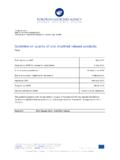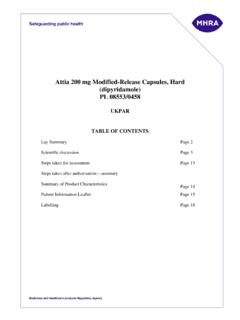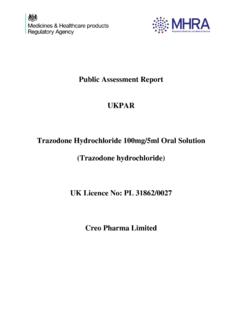Transcription of DATA SHEET ADALAT 10 / ADALAT 20 Presentation
1 160509 ADALAT 1 data SHEET ADALAT 10 / ADALAT 20 nifedipine Name of Medicine ADALAT 10 (nifedipine) modified release tablets ADALAT 20 (nifedipine) modified release tablets Presentation Each ADALAT 10 modified release tablet contains 10 mg nifedipine Each ADALAT 20 modified release tablet contains 20 mg nifedipine Round to convex modified release tablet and grey-pink coated. Clinical Particulars Indications Treatment of coronary heart disease Chronic stable angina pectoris (angina of effort) Treatment of hypertension Dosage and Method of Administration Dosage Regimen As far as possible the treatment must be tailored to the needs of the individual according to the severity of the disease and the patient's response. Depending on the clinical picture in each case, the basic dose must be introduced gradually.
2 In patients with mild, moderate or severe impaired liver function careful monitoring and a dose reduction may be necessary. The pharmacokinetics of nifedipine has not been investigated in patients with severe hepatic impairment (see Special Warnings and Precautions for Use and Pharmacokinetic Properties). ADALAT 10 is particularly suitable for dose titration. Dose titration is recommended for hypertensives with severe cerebrovascular disease and for patients, who because of low body weight or multiple therapies with other antihypertensive drugs, are likely to have an excessive reaction to nifedipine. In addition, for patients who experience adverse effects in response to the nifedipine treatment, a finer dose adjustment is desirable and should be individually stabilised with ADALAT 10.
3 Unless otherwise prescribed, the following dosage guidelines apply for adults: 160509 ADALAT 2 In Coronary Heart Disease: Chronic stable angina pectoris One ADALAT 10 tablet twice daily (angina of effort) (2 x 10 mg/day) One ADALAT 20 tablet twice daily (2 x 20 mg/day) If higher dosages are necessary, the dose can be increased in stages up to maximum 60 mg daily. In Hypertension: One ADALAT 10 tablet twice daily (2 x 10 mg/day) One ADALAT 20 tablet twice daily (2 x 20 mg/day) If higher dosages are necessary the dose can be increased in stages up to maximum 60 mg daily. Co-administration with CYP 3A4 inhibitors or CYP 3A4 inducers may result in the recommendation to adapt the nifedipine dose or not to use nifedipine at all (see Interaction with other Medicinal Products and other Forms of Interaction).
4 Duration of Use The attending doctor will determine the duration of use. Because ADALAT has a pronounced antiischemic and antihypertensive action, it should be discontinued gradually, particularly when high doses are used. Method of Administration Tablets are generally swallowed whole with a little liquid, irrespective of meal times. Simultaneous food intake leads to delayed but not reduced absorption. Grapefruit juice is to be avoided (see Interaction with other Medicinal Products and other Forms of Interaction). Do not chew or halve tablet. The recommended dosage interval for ADALAT 10 or ADALAT 20 is about 12 hours and should not be less than 4 hours. Additional Information on Special Populations Pediatric patients The safety and efficacy of ADALAT in children below 18 years has not been established.
5 Geriatric patients The pharmacokinetics of ADALAT are altered in the elderly so that lower maintenance doses of ADALAT may be required compared to younger patients. Patients with hepatic impairment In patients with mild, moderate or severe impaired liver function, careful monitoring and a dose reduction may be pharmacokinetics of nifedipine has not been investigated in patients with severe hepatic impairment (see Special Warnings and Precautions for Use and Pharmacokinetic properties). 160509 ADALAT 3 Patients with renal impairment Based on pharmacokinetic data , no dosage adjustment is required in patients with renal impairment (see Pharmacokinetic Properties). Contraindications ADALAT must not be used in cases of known hypersensitivity to nifedipine or to any of the excipients (see Special Warnings and Precautions of Use and List of Excipients).
6 ADALAT must not be used in pregnancy before week 20 and during breastfeeding (see Pregnancy and Lactation). ADALAT must not be used in cases of cardiovascular shock. ADALAT must not be used in combination with rifampicin because efficient plasma levels of nifedipine may not be obtained due to enzyme induction (see Interaction with other Medicinal Products and other Forms of Interaction). Special Warnings and Precautions for Use Care must be exercised in patients with very low blood pressure (severe hypotension with systolic pressure less than 90 mmHg), in cases of manifest heart failure and in the case of severe aortic stenosis. There are no safety and efficacy data from well-controlled studies in pregnant women (see Pregnancy and Lactation). Animal studies have shown a variety of embryotoxic, placentotoxic and fetotoxic effects when administered during and after the period of organogenesis (see Preclinical Safety data ).
7 From the clinical evidence available, a specific prenatal risk has not been identified. Although an increase in perinatal asphyxia, caesarean deliveries as well as prematurity and intrauterine growth retardation have been reported. It is unclear whether these reports are due to the underlying hypertension, its treatment or to a specific drug effect. The available information is inadequate to rule out adverse drug effects on the unborn and newborn child. Therefore any use in pregnancy after week 20 requires a very careful individual risk benefit assessment and should only be considered if all other treatment options are either not indicated or have failed to be efficacious. Careful monitoring of blood pressure must be exercised, also when administered nifedipine with intravenous magnesium sulfate, owing to the possibility of an excessive fall in blood pressure, which could harm both mother and fetus.
8 In patients with mild, moderate or severe impaired liver function careful monitoring and a dose reduction may be necessary. The pharmacokinetics of nifedipine has not been investigated in patients with severe hepatic impairment (see Dosage and Method of Administration and Pharmacokinetic properties). Therefore, nifedipine should be used with caution in patients with severe hepatic impairment. 160509 ADALAT 4 ADALAT OROS modified release tablets are not bioequivalent to immediate release nifedipine capsules and tablets and patients should be carefully monitored if it is decided to switch between immediate release and modified release nifedipine or vice versa. Nifedipine is metabolised via the cytochrome P450 3A4 system. Medicines that are known to either inhibit or to induce this enzyme system may therefore alter the first pass or the clearance of nifedipine (see Interaction with other Medicinal Products and other Forms of Interaction).
9 Medicines, which are weak to moderate inhibitors of the cytochrome P450 3A4 system and therefore may lead to increased plasma concentrations of nifedipine, are, : - macrolide antibiotics ( , erythromycin), - anti-HIV protease inhibitors ( , ritonavir), - azole antimycotics ( , ketoconazole), - the antidepressants nefazodone and fluoxetine, - quinupristin/dalfopristin, - valproic acid, - cimetidine. Upon co-administration with these medicines, the blood pressure should be monitored and, if necessary, a reduction of the nifedipine dose should be considered. Since this medicinal product contains lactose, patients with rare hereditary problems of galactose intolerance, the Lapp lactase deficiency or glucose-galactose malabsorption should not take this medicine. For use in special populations, see Dosage and Method of Administration.
10 Interaction with other Medicinal Products and other Forms of Interaction Medicines that affect nifedipine The blood pressure lowering effect of nifedipine may be potentiated by co-administration of other antihypertensive medicines. When ADALAT is administered simultaneously with -receptor blockers the patient should be carefully monitored, since fairly severe hypotension can occur. Deterioration of heart failure is also known to develop in isolated cases. Nifedipine is metabolised via the cytochrome P450 3A4 system, located both in the intestinal mucosa and in the liver. Medicines that are known to either inhibit or to induce this enzyme system may therefore alter the first pass (after oral administration) or the clearance of nifedipine (see Special Warnings and Precautions for Use).















